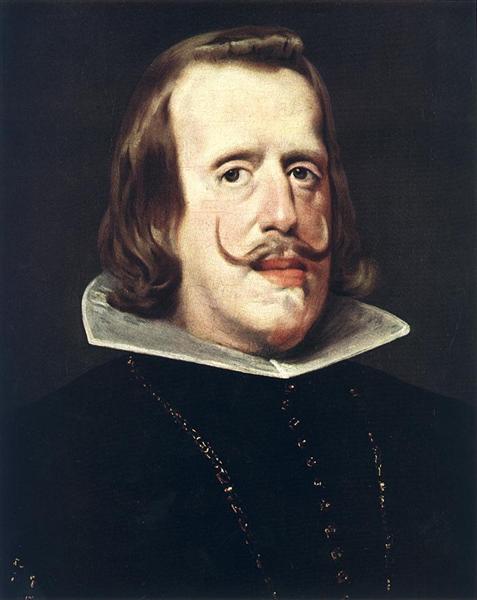Description
Diego Velázquez's painting "Portrait of Philip IV" (1653) is a masterpiece of Spanish Baroque art that captures not only the figure of the monarch, but also the essence of a time marked by the splendor and tensions of the court. The depiction of Philip IV is framed in a tradition of royal portraiture that dates back to earlier times, but Velázquez manages to infuse this work with a unique psychological depth and a sense of immediacy that is remarkable.
From the first glance, the composition presents the king in a frontal pose, a choice that highlights his status and authority. Philip IV is depicted in majestic attire, adorned with the insignia of the Order of Saint Januarius, which serves to emphasize his position. The richness of the textiles, reflected in the subtle nuances of the fabric of his clothing, exhibits Velázquez's ability to capture light and the texture of materials, a distinctive feature of his style. The stark contrast established between the darkness of the background and the radiance of the king naturalizes the figure, while suggesting an air of solemnity and dignity.
The use of colour is equally fascinating. The dark tones of the background provide a silence that allows the figure of Philip IV to stand out more strongly. The lights and shadows, meticulously worked, give shape and volume to his face and figure, showing Velázquez's mastery in the use of chiaroscuro. The face of the king, portrayed with marked realism, shows a look that is introspective, revealing his character and the burdens that weighed on him in his role as monarch in times of political and economic crisis.
There are no playful or decorative elements in this piece; it is devoid of the exuberance often found in the works of other contemporaries. Instead, the restraint and elegance of the portrait speaks to the nobility and majesty of the sitter, as well as to Velázquez’s focus on capturing the humanity behind royalty. This ability to humanize such powerful figures is one of the reasons why his work has endured and continues to have a profound impact on contemporary art.
Diego Velázquez, throughout his career, showed a remarkable evolution in his technique and approach to portraiture. Starting from earlier works, one can observe a journey towards a more psychological and authentic representation of his models. Other works, such as "Las Meninas", also reflect this ability of Velázquez to mix the formal with the intimate, resulting in a unique exploration of realism. In "Portrait of Philip IV", this search is also manifested in the expression of the king, which goes beyond the stereotypical rigidity often associated with monarchical portraits.
In terms of historical context, Philip IV was a king whose reign was characterized by internal and external political struggles, and Velázquez's painting, by capturing him so carefully, also offers us a window into the conflicts and grandeur of his time. Velázquez, who was also a court painter, leaves us a legacy that speaks to the relationship between the artist and power, as well as the struggle for authentic representation in art.
In conclusion, "Portrait of Philip IV" is not just a depiction of the king, but a testament to Velázquez's virtuosity and his ability to transcend the portrait genre. With its refined technique and emotional depth, this work continues to invite the viewer to meditate on the human condition and the inevitability of time, themes that, through the centuries, remain relevant. In every stroke and in every shadow, Velázquez reminds us that behind royalty there is a human being with thoughts, concerns and, above all, a story to tell.
KUADROS ©, a famous painting on your wall.
Hand-made oil painting reproductions, with the quality of professional artists and the distinctive seal of KUADROS ©.
Painting reproduction service with satisfaction guarantee. If you are not completely satisfied with the replica of your painting, we will refund 100% of your money.

